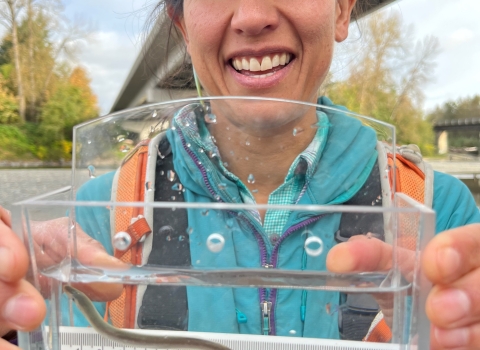"We now have a preliminary conclusion on the cause of the seabird deaths: starvation,) said Vivian Mendenhall, a senior seabird biologist with the U.S. Fish and Wildlife Service (Service). "It seems that they may have starved because of the very same calm, sunny weather that we humans enjoyed so much--the conditions scientists call El Nino.
Seabirds were found dead from the western Gulf of Alaska to the Chukchi Sea. Most of the deaths were among Short-tailed Shearwaters, a dark bird that is similar in shape to a small gull. Other species died in some areas: Black-legged Kittiwakes on the Alaska Peninsula, and murres and other diving species in parts of the west and north.
This die-off was very widely reported, considering the remoteness of the area. Data received first from fishers and local residents throughout the area was later augmented by data gathered from agencies and research vessels.
"We are very grateful to all the people who called us. Villagers and fishers created the picture of what was happening out there. Without the help of local people, we would not have known how big this was," said Mendenhall, who gathered the information as it arrived at the Service. Agencies also collected valuable information. Ground surveys were conducted on 21 beaches; the Service and the Alaska Department of Fish and Game conducted aerial surveys. Cooperators sent specimens of dead birds for autopsy.
"We will never know how many seabirds we lost, but it appears that this may be one of the largest seabird die-offs ever recorded," says Mendenhall.
In the first phase of the die-off, Common Murres were found on the beaches and waters of Nunivak and on the nearby mainland in May. The next reports of dead birds came from St. Lawrence at the end of July. Several hundred carcasses there included murres, Horned Puffins, kittiwakes, and shearwaters.
During the first week of August, Short-tailed Shearwaters and Black-legged Kittiwakes died on both sides of the Alaska Peninsula. Thousands of dead birds were reported in tide rips near shore and on beaches across the lower half of the peninsula. Within a short time, shearwaters began to die throughout a huge area of the Bering Sea. Freshly dead shearwaters (as well as large flocks of live ones) were seen on both sides of the Aleutian Islands as far west as Adak.
Dead shearwaters washed up on the Pribilofs and near Anadyr (Russia). They appeared on the Bristol Bay coast and St. Lawrence by the 3rd week of August. Dead birds counted on beaches ranged from 17 to 100 per mile on the Alaska Peninsula and up to 500 per mile in the Bering Sea.
A variety of species were found dead north of the Bering Strait in late August. Murres, Blacklegged Kittiwakes, and Short-tailed Shearwaters were reported near Kivalina and Point Hope.
Many people saw birds behaving abnormally. Flocks of shearwaters were seen feeding within 100 yards of shore, whereas these birds normally stay much farther offshore. Shearwaters and kittiwakes in the Gulf of Alaska were attempting to grab food out of fishing gear and perching on vessels. Some were unable to fly away from approaching vessels and sat motionless with their heads drooping. Shearwaters were seen in the bizarre habitats (for them) of rivers and lakes. Dead birds were thin and light in weight.
The evidence suggested birds were struggling to find food, and that many were starving. Autopsy results show the same: dead birds had almost no body fat, wasted muscles, and some were anemic.
The birds lack of food appears to have been caused by the unusual conditions at sea during the summer of 1997. Scientists are still searching for a complete explanation of the anomalous conditions. However, some clues are emerging. Seabirds find all their food at sea, searching out schools of small fish and tiny shrimp-like zooplankton. Surface waters were very warm in the Gulf of Alaska and much of the Bering Sea in 1997, which may have forced the small fish into deeper, cooler water where some birds could not find them. The calm weather also meant that nutrients that nourish the birds prey were not stirred up from the bottom. In a normal summer, several strong storms mix the water thoroughly.
Most birds, even in the species that "died off", survived the summer. Most Alaskan seabird species appear not to have been affected at all (38 species breed in Alaska, and two shearwaters visit during the summer). No unusual numbers of birds died in the northern and eastern Gulf of Alaska. Even kittiwakes, which failed to raise young and died in unusual numbers in El Nino year of 1983, survived and reproduced normally in most parts of Alaska in 1997.
The Service and other researchers are continuing to analyze information, and may get further insights into causes of the die-off in the coming months. The Service plans to monitor populations of birds next year to check on effects of the die-off.
"This El Nino is the biggest ever recorded," said Mendenhall, "and the meteorologists tell us it isnt over. We may see another round of problems for birds or marine mammals in the coming months. We hope people will call us if they see something unusual."
-FWS-


